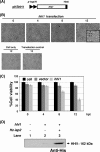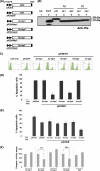Heliothis zea nudivirus 1 gene hhi1 induces apoptosis which is blocked by the Hz-iap2 gene and a noncoding gene, pag1
- PMID: 21543471
- PMCID: PMC3126586
- DOI: 10.1128/JVI.01843-10
Heliothis zea nudivirus 1 gene hhi1 induces apoptosis which is blocked by the Hz-iap2 gene and a noncoding gene, pag1
Abstract
Heliothis zea nudivirus 1 (HzNV-1 or Hz-1 virus), previously regarded as a nonoccluded baculovirus, recently has been placed in the Nudivirus genus. This virus generates HzNV-1 HindIII-I 1 (hhi1) and many other transcripts during productive viral infection; during latent viral infection, however, persistency-associated gene 1 (pag1) is the only gene expressed. In this report, we used transient expression assays to show that hhi1 can trigger strong apoptosis in transfected cells, which can be blocked, at least partially, by the inhibitor of apoptosis genes Autographa californica iap2 (Ac-iap2) and H. zea iap2 (Hz-iap2). In addition to these two genes, unexpectedly, pag1, which encodes a noncoding RNA with no detectable protein product, was found to efficiently suppress hhi1-induced apoptosis. The assay of pro-Sf-caspase-1 processing by hhi1 transfection did not detect the small P12 subunit at any of the time intervals tested, suggesting that hhi1 of HzNV-1 induces apoptosis through alternative caspase pathways.
Figures







Similar articles
-
A non-coding RNA of insect HzNV-1 virus establishes latent viral infection through microRNA.Sci Rep. 2011;1:60. doi: 10.1038/srep00060. Epub 2011 Aug 11. Sci Rep. 2011. PMID: 22355579 Free PMC article.
-
MicroRNAs derived from the insect virus HzNV-1 promote lytic infection by suppressing histone methylation.Sci Rep. 2018 Dec 13;8(1):17817. doi: 10.1038/s41598-018-35782-w. Sci Rep. 2018. PMID: 30546025 Free PMC article.
-
The early gene hhi1 reactivates Heliothis zea nudivirus 1 in latently infected cells.J Virol. 2010 Jan;84(2):1057-65. doi: 10.1128/JVI.01548-09. Epub 2009 Nov 4. J Virol. 2010. PMID: 19889784 Free PMC article.
-
In vitro host range of Autographa californica nucleopolyhedrovirus recombinants lacking functional p35, iap1 or iap2.J Gen Virol. 1999 Apr;80 ( Pt 4):1055-1066. doi: 10.1099/0022-1317-80-4-1055. J Gen Virol. 1999. PMID: 10211976
-
Nudiviruses and other large, double-stranded circular DNA viruses of invertebrates: new insights on an old topic.J Invertebr Pathol. 2009 Jul;101(3):187-93. doi: 10.1016/j.jip.2009.03.013. Epub 2009 May 19. J Invertebr Pathol. 2009. PMID: 19460388 Review.
Cited by
-
A non-coding RNA of insect HzNV-1 virus establishes latent viral infection through microRNA.Sci Rep. 2011;1:60. doi: 10.1038/srep00060. Epub 2011 Aug 11. Sci Rep. 2011. PMID: 22355579 Free PMC article.
-
MicroRNAs derived from the insect virus HzNV-1 promote lytic infection by suppressing histone methylation.Sci Rep. 2018 Dec 13;8(1):17817. doi: 10.1038/s41598-018-35782-w. Sci Rep. 2018. PMID: 30546025 Free PMC article.
-
Baculovirus IE2 Stimulates the Expression of Heat Shock Proteins in Insect and Mammalian Cells to Facilitate Its Proper Functioning.PLoS One. 2016 Feb 10;11(2):e0148578. doi: 10.1371/journal.pone.0148578. eCollection 2016. PLoS One. 2016. PMID: 26863132 Free PMC article.
-
Transcriptional dynamics during Heliothis zea nudivirus 1 infection in an ovarian cell line from Helicoverpa zea.J Gen Virol. 2025 Jan;106(1):002066. doi: 10.1099/jgv.0.002066. J Gen Virol. 2025. PMID: 39804289 Free PMC article.
-
Baculovirus Lymantria dispar multiple nucleopolyhedrovirus IAP2 and IAP3 do not suppress apoptosis, but trigger apoptosis of insect cells in a transient expression assay.Virus Genes. 2012 Oct;45(2):370-9. doi: 10.1007/s11262-012-0783-0. Epub 2012 Jul 15. Virus Genes. 2012. PMID: 22798056
References
-
- Ahmad M., et al. 1997. Spodoptera frugiperda caspase-1, a novel insect death protease that cleaves the nuclear immunophilin FKBP46, is the target of the baculovirus antiapoptotic protein p35. J. Biol. Chem. 272:1421–1424 - PubMed
-
- Alimonti J. B., Ball T. B., Fowke K. R. 2003. Mechanisms of CD4+ T lymphocyte cell death in human immunodeficiency virus infection and AIDS. J. Gen. Virol. 84:1649–1661 - PubMed
-
- Ayres M. D., Howard S. C., Kuzio J., Lopez-Ferber M., Possee R. D. 1994. The complete DNA sequence of Autographa californica nuclear polyhedrosis virus. Virology 202:586–605 - PubMed
Publication types
MeSH terms
Substances
LinkOut - more resources
Full Text Sources
Other Literature Sources
Miscellaneous

